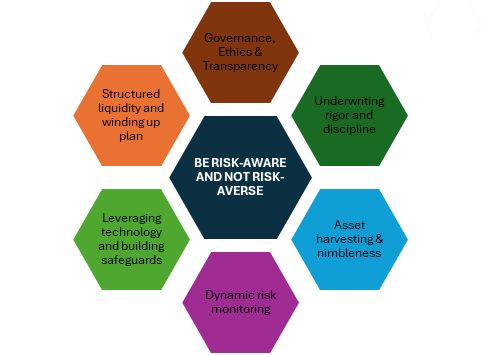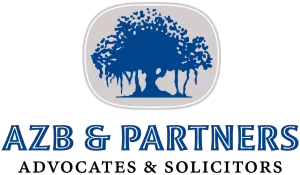- within Finance and Banking topic(s)
- in United States
- within Finance and Banking topic(s)
- with Senior Company Executives, HR and Finance and Tax Executives
- in United States
- with readers working within the Accounting & Consultancy, Banking & Credit and Insurance industries
The Alternative Investment Funds (AIF) industry has witnessed tremendous growth in the last decade on the back of quality active fund managers and investors seeking diversification beyond traditional investment options. However, the chase for returns may push one into a labyrinth of risks. As Warren Buffett famously said, "risk comes from not knowing what you're doing." For fund managers, the challenge is not just knowing what they are doing. For them, it is imperative to know what everyone else (such as regulators, investors, promoters, politicians and world at large) might do next as that could have a direct or indirect bearing on the fund's investment and exit strategy.
In essence, risk is the probability of occurrence or non-occurrence of a parameter/circumstance that could, or potentially could, adversely affect the objectives of the fund. Risk monitoring, mitigation and redressal is a dynamic process - requiring real-time proactive monitoring of present/future risks, foreseeable/unforeseeable risks, measurable/unmeasurable risks.
The objective of this article is to take the reader on a journey through the lifecycle of a fund, spotlighting risks at key stages and offering insights for external / in-house advisors tasked with fulfilling their applicable role of legal tacticians, risk sentinels, and compliance ninjas. However, by no means, it is meant to be an exhaustive playbook.

- Fund Formation: Blueprint is Drawn and Risks are Mapped
The formation of a fund is akin to laying the foundation of a skyscraper, and any misstep could reverberate for years. Some key decisions in fund formation stage are:
- Finalizing investment strategy with due care: assessing whether there is a market for the new fund product will address the 'demand' for capital. However, knowing whether the fund strategy aligns with investor preferences, goals and risk profile will address the 'supply' side of capital. Private Placement Memorandum (PPM) becomes a key document that must be drafted with a keen eye, clear articulation of investment thesis, describe process of identification of opportunities, underwriting strategies, target return, sectoral focus, disclosures on risk factors as well as conflicts of interest. Leaving the investment strategy undefined or vague keeps the door open for disputes to creep in at a later stage. Trust is the true currency for a fund manager and that is gained through transparency in selecting, making and divesting investments as per clear and pre-agreed strategy.
- Governance and compliance culture: The tone must be set from the top, zero tolerance to cutting corners. It is imperative that governance and compliance framework is built upfront. Bad culture can bring down an institution like a jenga tower. In today's world, regulators are empowered with technological tools as well as wide powers. A breach is more easily detectable as well as stricter penalties can be imposed. Cost of non-compliance is getting more expensive. Build your retirement home or squander money on hefty personal fines – choice should be a no-brainer!
- Fundraising: Takes Two to Tango
Fund raising can be tough and one must be vigilant due private placement requirements. The investors rely on expertise of the fund manager, skills of the investment team, institutional / professional structure, and ultimately the commercial terms in the fund documents before committing to any fund. Some pitfalls between the proverbial cup and the lip could be:
- Trying to wing it: not obtaining marketing and placement advice from experts in each country or indulging in 'suitcase banking'. Saving up on time or advisor / agent fees may well lead to eking out fines and litigator fees to bail yourself out.
- Lack of preparation :inadequate time and attention to marketing materials or falling into the trap of engaging with unlicensed or inexperienced placement agents. Failure to ensure disclosures meet the standards of the country where the AIF is being marketed. Promising 'guaranteed' or 'assured' returns or misrepresenting past track record by selective disclosures etc. could lead to crossing wires with regulators across jurisdictions.
- Inadequate procedures :while money is king, fund managers must exercise caution when onboarding investors. Conducting 'eligible investor' checks, KYC and AML checks, ABAC and sanctions check, politically exposed persons (PEP) checks are extremely essential to ensure the fund structure is not compromised. With securities market regulator (SEBI) adding anti-abuse provisions under the AIF Regulations, the onus is clearly cast on fund managers to ensure all relevant boxes are ticked before admitting potential investors in the fund. At the same time, power must be retained in the fund documents to do mandatory redemptions, excuse investors as well as take action against defaulters so as to insulate the fund from change in circumstances of one or more errant investor.
One must also not lose sight of keeping the momentum of fund raising going in between closings. Thus, managing the pace of cash flows, incoming (fund raising) versus outgoing (deployment, fund expenses) is a delicate balancing act and if not handled well could not only create bottlenecks and operational challenges but also drag down the IRR which could impact overall performance.
- Investment Period: Real Action, Risk in Motion
Once the commitments have been raised, pressure to deploy begins. A fund manager must know what is being acquired, stay true to why was it acquired and monetise it at the right time for generating superior risk-adjusted returns for the investors. Below could be regarded as foundation to build a strong investing edifice:
- robust and independent underwriting: investment committee and investment team with clear roles, responsibilities and operational policies (such as investment guidelines, allocation of investment policy, conflict of interest policies) must be in place. There must be no fear to walk away from a deal as sometimes the best investment is the one that was not done!
- pricing discipline is crucial: the drag on investment returns due to an expensive entry price can rarely be recovered.
- due diligence rigor: relevant, appropriate and comprehensive due diligence must be undertaken to cover all key areas (such as legal, financial, technical, operational, tax, commercial).
- portfolio mix: diversification is key, be it investment limits, sector exposure, geographical coverage, deal structure and its complexity/dynamics or investment horizon.
- sanctity of books of accounts must be maintained: investments must also be carried at the right valuation. Mark-to-myth accounting is not a recognised methodology!
- Oversight, Value Creation and Monetisation: The Long Haul
This is where value can either be created or eroded. Deftly navigating below stages, makes or shatters the track record of a fund manager.
- active oversight of investee companies is non-negotiable: Fund managers have to ensure that culture, good practices and accountability is drilled into the investee companies to improve financial performance, compliance, and ESG standards. A good fund manager doesn't just write cheques – she writes the playbook!
- disciplined approach to asset management :harvesting an investment is as important if not more than making the investment. As Peter Drucker said, "what gets measured gets managed." The corollary would be, what gets ignored, gets litigated.
- dynamic risk reviews: must be conducted regularly, with strategies adjusted in response to change in parameters mapped on the risk heatmap will stand in good stead.
- performance benchmarking: against industry standards is a regulatory requirement. However, a truthful review of one's performance against peers can become a valuable tool.
- transparent and timely reporting :including NAV disclosures, is essential to keep the fund in good standing with investors and regulators.
- nimbleness is an in-demand skillset :in today's volatile global environment, geo-political fallouts, climate change and technological disruptions, fund managers have to be agile and may even need to restructure businesses of investee companies to mitigate these risks and preserve value. An unpredictable business and regulatory environment is the new normal.
- Winding Up and Liquidation: The Last Lap
Exit roadmaps should be planned early, with divestment strategies (strategic sale, IPO, merger, PE secondary) tailored to each investee company and the market it operates. Several funds failed to exit their investments during original tenure plus extended tenure(s). In order to hold fund managers accountable, SEBI had to step in and has created 'liquidation scheme' framework under the AIF regulations.
However, moving towards end of a fund's life, is no time to relax yet.
- a structured winding-up plan: is essential, with clear milestones for liquidation of remaining assets and liabilities (including small vendor claims) as well as completing any in-specie distributions that may be required.
- auditof closing accounts needs to be undertaken and final reporting protocols wrapped up. Proper assessment to contingent liabilities needs to be undertaken, reserves or mechanics for giveback to be put in place to insulate impact of post fund-term indemnification claims.
- legal closurerequires filing of all statutory and regulatory documents, including execution of termination deed, as applicable.
- safe and secure custodyof all records of the fund that is being closed needs to be ensured so that archives are easily retrievable when required in the future for any legal, regulatory, tax or arbitration proceeding.
Conclusion :risk is an inherent part of a fund's lifecycle, but with the right framework, it can be a strategic asset rather than a threat. Fund managers who adopt a lifecycle-based, proactive risk management approach are more likely to build sustainable, high-performing fund platforms that could weather contingencies, uncertainties or complexities. In today's volatile and reputation-sensitive environment, embedding risk consciousness into every decision, process, and relationship is in fact a competitive advantage.
This article was developed with writing assistance from Khushi Agarwal.
Originally published Jul 15, 2025.
The content of this article is intended to provide a general guide to the subject matter. Specialist advice should be sought about your specific circumstances.


